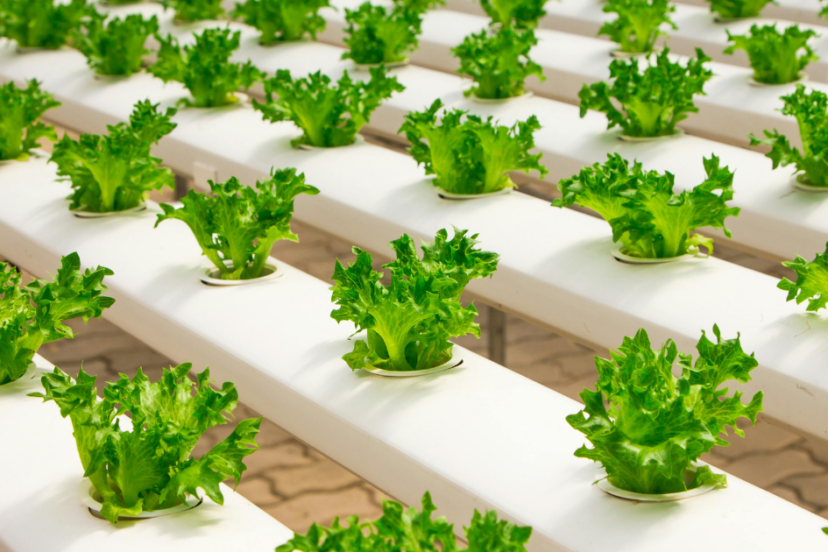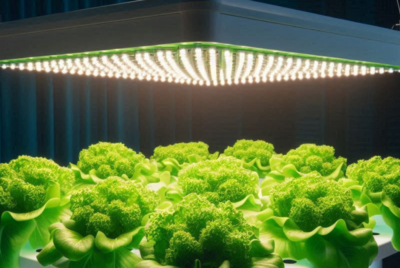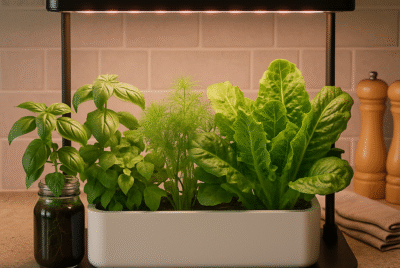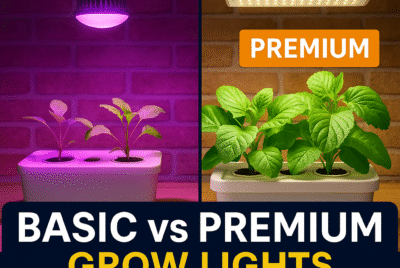Hydroponic Plants: 4 Best Types
Introduction
Hydroponics is an innovative and efficient way to grow plants without the need for soil. This method uses nutrient-rich water solutions to provide plants with the essential minerals they need for growth. Hydroponics has gained popularity due to its ability to produce high yields in a controlled environment, making it an excellent option for both hobbyists and commercial growers. In this article, I’ll share my experience and insights on the best plants for hydroponics, along with helpful tips, detailed reviews, and practical advice to help you succeed in your hydroponic gardening journey.
Understanding Hydroponics
Hydroponics is a method of growing plants using a water-based nutrient solution instead of soil. This technique allows for greater control over the growing environment, leading to faster growth rates and higher yields compared to traditional soil-based gardening. There are several types of hydroponic systems, including nutrient film technique (NFT), deep water culture (DWC), aeroponics, and drip systems, each with its own set of advantages and applications.
Benefits of Hydroponic Gardening
1. Faster Growth Rates: Plants grown hydroponically can grow up to 50% faster than those grown in soil because they have direct access to nutrients and water.
2. Higher Yields: Hydroponic systems can produce higher yields per square foot compared to traditional soil gardening.
3. Water Efficiency: Hydroponic systems use up to 90% less water than soil-based gardening, making them more sustainable and environmentally friendly.
4. Space Efficiency: Hydroponic systems can be set up vertically or in small spaces, making them ideal for urban environments and indoor gardening.
5. Reduced Pest and Disease Issues: Growing plants in a controlled environment reduces the risk
of pest infestations and soil-borne diseases, leading to healthier plants and less need for chemical interventions.
Types of Hydroponic Systems
1. Nutrient Film Technique (NFT): This system involves a continuous flow of nutrient solution over the roots of the plants. It’s suitable for lightweight plants like lettuce and herbs.
2. Deep Water Culture (DWC): In this system, plant roots are suspended in a nutrient-rich oxygenated water solution. It’s ideal for larger plants like tomatoes and cucumbers.
3. Aeroponics: This advanced system involves misting plant roots with a nutrient solution. It’s highly efficient but requires careful maintenance.
4. Drip Systems: Nutrient solution is dripped directly onto the base of each plant. This method is versatile and can support a wide range of plants.
5. Wick Systems: The simplest form of hydroponics, where a wick draws nutrient solution from a reservoir to the plant roots. It’s best for small plants and herbs.
Criteria for Choosing Plants for Hydroponics
When selecting plants for your hydroponic garden, consider the following criteria to ensure a successful and productive setup:
1. Growth Rate: Fast-growing plants are more suitable for hydroponic systems because they can quickly adapt to the nutrient-rich environment and maximize yield in a shorter time.
2. Root Structure: Plants with simpler root systems are easier to manage in hydroponic systems. Complex root systems can become tangled and may require more space.
3. Water and Nutrient Requirements: Choose plants with similar water and nutrient needs to simplify the management of your hydroponic garden.
4. Light Requirements: Ensure your plants have compatible light needs, whether you are using natural sunlight or artificial grow lights.
5. Climate Tolerance: Select plants that can thrive in the controlled environment you can provide, taking into account temperature and humidity levels.
4 Top Types of Plants for Hydroponics
1. Leafy Greens
Leafy greens are a staple in hydroponic gardening due to their rapid growth and relatively low nutrient requirements. Here are five top leafy greens for hydroponics:
Lettuce
Lettuce grows quickly and is easy to manage, making it perfect for hydroponics.
1. Butterhead Lettuce: 9/10 – Soft leaves, mild flavor, high yield.
2. Romaine Lettuce: 8/10 – Crisp texture, ideal for salads, moderate growth rate.
3. Iceberg Lettuce: 7/10 – Crunchy, less nutrient-dense, requires cooler temperatures.
4. Leaf Lettuce: 9/10 – Diverse colors and textures, fast growth.
5. Little Gem Lettuce: 8/10 – Sweet taste, compact growth, ideal for small spaces.
Spinach
Spinach offers excellent yields and nutrition but needs cooler temperatures.
1. Bloomsdale Spinach: 8/10 – Deep green leaves, rich flavor, high yield.
2. Savoy Spinach: 7/10 – Curly leaves, slower growth, flavorful.
3. Baby Spinach: 9/10 – Tender leaves, fast growth, versatile.
4. Smooth-Leaf Spinach: 8/10 – Easy to clean, moderate yield.
5. Red Spinach: 8/10 – Vibrant color, high in antioxidants, requires cooler temperatures.
Kale
Kale is nutritious and versatile, thriving well in hydroponic systems.
1. Curly Kale: 9/10 – Robust flavor, high yield, tolerant of varying conditions.
2. Lacinato Kale: 8/10 – Unique texture, rich flavor, slower growth.
3. Red Russian Kale: 8/10 – Tender leaves, colorful, moderate yield.
4. Siberian Kale: 9/10 – Cold-hardy, large leaves, high yield.
5. Baby Kale: 8/10 – Mild flavor, fast growth, versatile.
Swiss Chard
Swiss chard is colorful and nutritious, a great addition to any hydroponic garden.
1. Rainbow Chard: 9/10 – Vibrant colors, high yield, attractive.
2. Fordhook Giant Chard: 8/10 – Large leaves, robust growth, versatile.
3. Ruby Red Chard: 8/10 – Deep red stems, flavorful leaves, moderate yield.
4. Bright Lights Chard: 9/10 – Multicolored stems, visually appealing, high yield.
5. Green Chard: 8/10 – Traditional variety, reliable growth, versatile.
Arugula
Arugula adds a spicy kick to dishes and is easy to grow hydroponically.
1. Wild Arugula: 8/10 – Intense flavor, small leaves, fast growth.
2. Garden Arugula: 8/10 – Milder taste, larger leaves, reliable yield.
3. Astro Arugula: 9/10 – Rapid growth, mild flavor, versatile.
4. Sylvetta Arugula: 8/10 – Strong peppery taste, fine leaves, moderate yield.
5. Wasabi Arugula: 9/10 – Unique wasabi-like flavor, fast growth, versatile.
2. Herbs
Herbs are well-suited for hydroponics due to their compact size and the continuous harvest they offer. Here are five top herbs for hydroponics:
Peppers
Peppers thrive well in hydroponic systems, providing a range of flavors.
1. Bell Peppers: 9/10 – Sweet and crunchy, available in various colors, high yield.
2. Jalapeño Peppers: 8/10 – Mildly hot, perfect for adding a kick to dishes, moderate yield.
3. Habanero Peppers: 8/10 – Extremely hot, used in spicy sauces, moderate yield.
4. Banana Peppers: 8/10 – Mildly sweet, often pickled or used in salads, moderate yield.
5. Cayenne Peppers: 8/10 – Hot, commonly dried and used as a spice, moderate yield.
Basil
Basil is aromatic and fast-growing, ideal for beginners.
1. Genovese Basil: 9/10 – Sweet, anise-like flavor, high yield, versatile.
2. Thai Basil: 8/10 – Distinct licorice flavor, moderate growth.
3. Lemon Basil: 9/10 – Citrus scent, versatile, fast growth.
4. Purple Basil: 8/10 – Deep purple leaves, mild flavor, moderate yield.
5. Holy Basil: 8/10 – Spicy aroma, medicinal uses, moderate growth.
Mint
Mint spreads quickly and is versatile in the kitchen.
1. Spearmint: 9/10 – Refreshing flavor, vigorous growth, versatile.
2. Peppermint: 8/10 – Stronger flavor, fast growth, great for teas.
3. Chocolate Mint: 8/10 – Unique flavor, moderate growth, versatile.
4. Apple Mint: 8/10 – Fruity undertone, fast growth, versatile.
5. Orange Mint: 8/10 – Citrus flavor, vigorous growth, great for drinks.
Cilantro
Cilantro grows fast and is highly flavorful, though some find its taste polarizing.
1. Calypso Cilantro: 9/10 – Slow-bolting, high yield, strong flavor.
2. Santo Cilantro: 8/10 – Abundant leaves, strong flavor, moderate yield.
3. Cruiser Cilantro: 8/10 – Large leaves, robust flavor, reliable growth.
4. Leisure Cilantro: 8/10 – Extended leaf production, high yield.
5. Moroccan Cilantro: 8/10 – Unique flavor profile, moderate yield.
Parsley
Parsley is a versatile herb that grows well in hydroponic systems.
1. Italian Flat-Leaf Parsley: 9/10 – Robust flavor, high yield, versatile.
2. Curly Parsley: 8/10 – Commonly used as a garnish, moderate yield.
3. Giant of Italy Parsley: 9/10 – Large leaves, high yield, versatile.
4. Hamburg Parsley: 8/10 – Edible roots, moderate yield.
5. Triple Curled Parsley: 8/10 – Very curly leaves, decorative, moderate yield.
Thyme
Thyme is hardy and offers a range of flavors for culinary applications.
1. Lemon Thyme: 8/10 – Citrus flavor, versatile, moderate growth.
2. Creeping Thyme: 8/10 – Low-growing, can also serve as ground cover, moderate yield.
3. German Thyme: 9/10 – Robust flavor, cold-hardy, high yield.
4. French Thyme: 8/10 – Milder flavor, used in French cuisine, moderate growth.
3. Fruits
Growing fruits hydroponically can be highly rewarding, offering fresh, flavorful produce. Here are five top fruits for hydroponics:
Strawberries
Strawberries are rewarding but require careful management.
1. June-Bearing Strawberries: 8/10 – Large crop in early summer, requires precise care.
2. Everbearing Strawberries: 8/10 – Two main harvests per year, continuous yield.
3. Day-Neutral Strawberries: 9/10 – Produces fruit throughout the growing season, consistent yield.
4. Alpine Strawberries: 8/10 – Small, intensely flavored berries, moderate yield.
5. Chandler Strawberries: 9/10 – Large, juicy berries, high yield.
Tomatoes
Tomatoes are a hydroponic staple, yielding juicy, flavorful fruits.
1. Cherry Tomatoes: 9/10 – Small, sweet, perfect for snacking, high yield.
2. Beefsteak Tomatoes: 8/10 – Large, meaty fruits, require more space, moderate yield.
3. Roma Tomatoes: 8/10 – Firm, fleshy, great for sauces, moderate yield.
4. Heirloom Tomatoes: 9/10 – Diverse flavors and colors, high yield, requires careful management.
5. Grape Tomatoes: 9/10 – Small, oblong, sweet, high yield.
Peppers
Peppers thrive in hydroponic systems, offering various flavors and colors.
1. Bell Peppers: 9/10 – Sweet, crunchy, versatile, high yield.
2. Jalapeño Peppers: 8/10 – Mildly hot, perfect for adding a kick to dishes, moderate yield.
3. Habanero Peppers: 8/10 – Extremely hot, used in spicy sauces, moderate yield.
4. Banana Peppers: 8/10 – Mildly sweet, often pickled or used in salads, moderate yield.
5. Cayenne Peppers: 8/10 – Hot, commonly dried and used as a spice, moderate yield.
Cucumbers
Cucumbers are highly productive in hydroponic setups.
1. English Cucumbers: 9/10 – Long, seedless, ideal for salads, high yield.
2. Persian Cucumbers: 9/10 – Small, crunchy, perfect for snacking, high yield.
3. Pickling Cucumbers: 8/10 – Short, bumpy, used for making pickles, moderate yield.
4. Armenian Cucumbers: 8/10 – Unique ridged variety, mild flavor, moderate yield.
5. Lemon Cucumbers: 8/10 – Round, yellow, citrus-like flavor, moderate yield.
Melons
Melons require careful management but offer rewarding harvests.
1. Cantaloupe: 8/10 – Sweet, juicy, requires precise care, moderate yield.
2. Honeydew Melon: 8/10 – Green-fleshed, known for its sweetness, moderate yield.
3. Watermelon: 7/10 – Requires larger setups, refreshing fruits, low yield per plant.
4. Galia Melon: 8/10 – Cross between cantaloupe and honeydew, unique flavor, moderate yield.
5. Charentais Melon: 8/10 – Small, intensely flavored French variety, moderate yield.
4. Vegetables
Hydroponic systems can support a wide range of vegetables, providing fresh produce year-round. Here are five top vegetables for hydroponics:
Carrots
Carrots can be successfully grown hydroponically, providing crunchy and sweet roots.
1. Nantes Carrots: 9/10 – Cylindrical, sweet, and crisp, high yield.
2. Chantenay Carrots: 8/10 – Short and thick, excellent flavor, moderate yield.
3. Imperator Carrots: 8/10 – Long, slender, commonly found in supermarkets, moderate yield.
4. Danvers Carrots: 8/10 – Tapered, great for heavy or clay soils, moderate yield.
5. Parisian Carrots: 8/10 – Small, round, and sweet, ideal for container growing, moderate yield.
Cucumbers
Cucumbers do exceptionally well in hydroponic systems.
1. English Cucumbers: 9/10 – Long, seedless, ideal for salads, high yield.
2. Persian Cucumbers: 9/10 – Small, crunchy, perfect for snacking, high yield.
3. Pickling Cucumbers: 8/10 – Short and bumpy, used for making pickles, moderate yield.
4. Armenian Cucumbers: 8/10 – Unique ridged variety with a mild flavor, moderate yield.
5. Lemon Cucumbers: 8/10 – Round, yellow cucumbers with a citrus-like flavor, moderate yield.
Eggplants
Eggplants thrive in hydroponic systems and produce glossy fruits.
1. Black Beauty Eggplant: 9/10 – Large, deep purple fruits, high yield.
2. Japanese Eggplant: 8/10 – Long, slender fruits with a delicate flavor, moderate yield.
3. Graffiti Eggplant: 8/10 – Striking purple and white striped fruits, moderate yield.
4. White Eggplant: 8/10 – Unique variety with a milder flavor and tender texture, moderate yield.
5. Thai Eggplant: 8/10 – Small and round, commonly used in Asian cuisine, moderate yield.
Zucchini
Zucchini is productive and versatile in hydroponic systems.
1. Green Zucchini: 9/10 – Common variety, used in a wide range of dishes, high yield.
2. Golden Zucchini: 9/10 – Bright yellow, slightly sweeter than green, high yield.
3. Pattypan Squash: 8/10 – Small, scalloped squash with a tender texture, moderate yield.
4. Romanesco Zucchini: 8/10 – Ribbed, green variety with a nutty flavor, moderate yield.
5. Round Zucchini: 8/10 – Unique, round variety, great for stuffing, moderate yield.
Beans
Beans are highly productive and easy to manage in hydroponic systems.
1. Green Beans: 9/10 – Common variety, tender and flavorful, high yield.
2. Lima Beans: 8/10 – Nutty flavor and buttery texture, moderate yield.
3. Black Beans: 8/10 – Small, versatile beans used in many dishes, moderate yield.
4. Kidney Beans: 8/10 – Large, red beans often used in chili, moderate yield.
5. Yellow Wax Beans: 8/10 – Tender and mild-flavored, bright yellow, moderate yield.
Additional Recommendations for Hydroponic Success
To ensure a successful and thriving hydroponic garden, consider the following additional recommendations:
Maintain Optimal Nutrient Balance
1. Regular Testing: Frequently test nutrient levels to ensure plants receive the right balance of nutrients.
2. Adjust Nutrient Solutions: Tailor nutrient solutions based on plant growth stages and specific needs.
3. Monitor pH Levels: Keep the pH level within the optimal range (usually between 5.5 and 6.5) for nutrient absorption.
4. Use Quality Nutrients: Invest in high-quality hydroponic nutrients designed for the specific plants you are growing.
5. Prevent Nutrient Lockout: Avoid overfeeding, which can cause nutrient lockout and harm plant health.
Ensure Proper Lighting
1. Select the Right Lights: Choose grow lights suitable for the plants you are growing, such as LEDs or HPS lights.
2. Maintain Light Cycles: Provide appropriate light cycles (e.g., 16 hours of light and 8 hours of darkness) to mimic natural conditions.
3. Adjust Light Height: Keep lights at the proper distance from plants to prevent burning and ensure even light distribution.
4. Monitor Light Intensity: Ensure plants receive adequate light intensity, especially during the flowering and fruiting stages.
5. Use Reflective Surfaces: Enhance light efficiency by using reflective surfaces like Mylar or white paint around the grow area.
Control Temperature and Humidity
1. Monitor Environmental Conditions: Regularly check temperature and humidity levels to ensure they are within the optimal range for your plants.
2. Use Fans and Ventilation: Promote air circulation and reduce humidity levels using fans and proper ventilation systems.
3. Employ Heaters or Coolers: Maintain consistent temperatures by using heaters or coolers as needed.
4. Install Humidifiers/Dehumidifiers: Adjust humidity levels with humidifiers or dehumidifiers to prevent mold and mildew.
5. Utilize Climate Control Systems: Invest in automated climate control systems for precise management of temperature and humidity.
Implement Pest Management Strategies
1. Regular Inspections: Conduct frequent inspections to detect pests early and prevent infestations.
2. Use Organic Pest Control: Apply organic pest control methods, such as neem oil or insecticidal soap, to manage pests.
3. Introduce Beneficial Insects: Use beneficial insects like ladybugs and predatory mites to naturally control pest populations.
4. Maintain Cleanliness: Keep the grow area clean and free of debris to reduce the risk of pest infestations.
5. Implement Crop Rotation: Rotate crops periodically to break pest and disease cycles.
Optimize Water Management
1. Regularly Change Water: Change the nutrient solution regularly to prevent the buildup of salts and contaminants.
2. Ensure Adequate Oxygenation: Use air stones or oxygen pumps to oxygenate the nutrient solution and prevent root rot.
3. Monitor Water Levels: Maintain proper water levels in the system to ensure consistent nutrient delivery.
4. Use Clean Water: Use filtered or distilled water to avoid introducing contaminants into the system.
5. Implement Water Temperature Control: Keep water temperature within the optimal range (usually between 65°F and 75°F) for plant health.
Conclusion
Hydroponic gardening offers numerous benefits, including faster plant growth, higher yields, and the ability to grow a wide variety of plants in controlled environments. By understanding the types of hydroponic systems, selecting appropriate plants, and following best practices for nutrient management, lighting, temperature control, pest management, and water management, you can create a successful and productive hydroponic garden. Whether you are a beginner or an experienced gardener, hydroponics provides an exciting and rewarding way to grow fresh, healthy produce year-round.
Frequently Asked Questions (FAQs)
1. What is the best plant to start with for beginners in hydroponics?
For beginners, lettuce is often the best plant to start with. It grows quickly, requires minimal maintenance, and can thrive in various hydroponic systems. Its fast growth and adaptability make it ideal for those new to hydroponics.
2. How often should I change the nutrient solution in my hydroponic system?
It’s generally recommended to change the nutrient solution every 1-2 weeks. This helps prevent nutrient imbalances, salt buildup, and the growth of harmful pathogens. Regular changes ensure your plants receive a consistent and balanced supply of nutrients.
3. What type of lighting is best for hydroponic plants?
LED grow lights are often considered the best for hydroponic plants due to their energy efficiency, low heat output, and ability to provide a full spectrum of light. They are suitable for all stages of plant growth, from seedling to flowering.
4. Can I grow root vegetables like carrots and potatoes in a hydroponic system?
Yes, root vegetables like carrots and potatoes can be grown hydroponically, but they require specific system adaptations. Deep Water Culture (DWC) or aeroponic systems can work well, as they provide enough space for root expansion and ensure proper oxygenation and nutrient delivery.
5. How can I prevent pests in my hydroponic garden?
Preventing pests in a hydroponic garden involves regular monitoring, maintaining cleanliness, using organic pest control methods, and introducing beneficial insects. Keeping the environment clean and free of debris, along with employing good cultural practices, can significantly reduce the risk of pest infestations.
*We may earn a commission from purchases made through our links, at no cost to you. This does not affect our product recommendations. Please see our disclosure to learn more.




